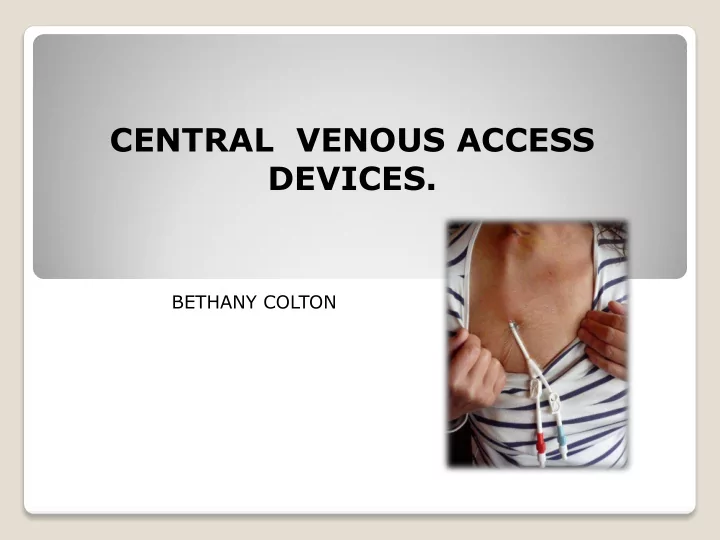

CENTRAL VENOUS ACCESS DEVICES. BETHANY COLTON
Aims and Objectives • To know what central venous access devices (CVAD) are. • Types of CVADS used in haematology. • To understand why we use them • To know the complications of CVADS • And how to maintain the care of a CVAD
What is a cvad? • CVAD`S are IV catheters that terminate in the Superior Vena Cava just above the right atrium. • Short term CVAD`S are in place days to weeks. • Long term CVAD`S are in place weeks to years.
What sort of line is this? PICC LINE – Peripherally inserted central line.
What sort of line is this? HML – Hickman line
What sort of line is this? Apheresis Line - Double lumen tunnelled line.
HML
PICC LINE
Why do we use them IV therapy > 7 days Poor venous access Hyperosmolar solution (TPN) Infusions of vesicant or irritant chemotherapy Stability of patient requires multiple venous access sites or central venous access
How are HML and PICC lines similar • Tip placement in superior vena cava • Catheter material is soft & flexible • Require use of a 10ml or larger syringe • Radiological placement verification • Patency check prior to use • Require positive pressure
Advantages • Irritant drugs and fluids can be infused without damaging vein walls. • Enable rapid and reliable IV administration of drugs and fluids. • Increased bio-availability (Give concentrated meds safely e.g. Potassium). • Multiple lumens allows 2 or more incompatible drugs or fluid to be administered simultaneously • Easy blood sampling • Can be used for long term access
Disadvantages • Potential insertion complications; • Requires nursing staff to be trained • IV drug administration, requires added knowledge • Increased risk of systemic infection, bleeding, thrombosis & air embolism • Patient discomfort / immobility
Complications of CVADS • Occlusion • CVAD related infections • Phlebitis, oedema, cellulitis (PICC) • Venous air embolism • DVT
INFECTION Treating line associated infections are important and if not treated, can be life threatening. SYMPTOMS OF CVAD INFECTION • A high temperature (fever).temp of 38oC or above • Redness, swelling and pain around the exit site • Discoloured fluid coming from the exit site IF IN DOUBT ASK!!!!!!
After the line is inserted there are things we need to do to maintain the patency of the line and avoid infections Top Anchor Dressings Bungs Flushing Suture Suture HICKMAN 7 days 21 days Daily for 7 weekly Before and then weekly after use LINE there after and weekly PICC LINE N/A N/A Weekly Weekly Before and after use and weekly APHERESI 7 days NEVER Weekly Weekly Before and !!!!!! after use S LINE and weekly CVAD Maintenance
Cleaning a line As per table stated before the line needs cleaning ever week until the line is removed. To clean the line and exit site we use Chlorhexidine gluconate 2%. This is the only product we should be using and if patients are allergic/irritation occurs you are able to use normal saline 0.9%.
Why do we flush lines • To reduce the risk of the line blocking off due to bloods and drug particles remaining in the line • To keep the line patent • To minimise the risk of infection build up in line • To make sure the line is working properly
CVAD BINGO (line first then full house- Must shout HML instead of Bingo). If a line is infected a patient may feel ___________ at the site. PAIN There are two lumens on a Hickman Line the broader line is_____. Red Patient_______ is important before sending them home. Education Nurses and medics should regularly_____ the site for infection. Examine We often treat line infections with IV _________. Antibiotics We can easily obtain ______ from CVADS. Bloods CVADS Sit in the _______. Vena Cava
CVAD BINGO (line first then full house- Must shout HML instead of Bingo). The abbreviation for peripherally inserted central line is ________ PICC A sign of infection may be a raised ______ Temperature Sometimes lines have multiple Lumens We complete regular _______ to avoid blockages Flushing We do regular _________ to avoid infection Cleaning We use _______ technique when accessing Lines ANTT A sensitive dressing is a _________ Hydrafilm
CVAD BINGO (line first then full house- Must shout HML instead of Bingo). The sight may experience ________ if it is infected. Swelling We administer flushed via _______ 10mls or above. Syringes White dressings are called ______ Mepore The smaller lumen is the ________ lumen White If we suspect infection we take _______. Swabs We regularly change the _______ Dressings
How Do WE FLUSH A HICKMAN LINE Whenever accessing a Central venous device you should always use aseptic none touch technique (ANTT) . Prepare the patient • Examine the CVAD looking for signs of infection, damage, • dislodgement or phlebitis Prepare equipment and use appropriate work surface • Wash hands and apply non-sterile gloves • Check flushing solutions and draw up. • Remove gloves and transport equipment to patient preventing • contamination of key parts
Disinfect hands and apply sterile gloves Place sterile towel/gauze swab under the bungs of the CVAD device Clean the bung with chlorhexidine swab for 15 seconds and allow to dry Attach the 10ml syringe of sodium chloride 0.9% using the pulsed push pause technique HICKMAN LINE/APHERESIS LINE/PICC WITH CLAMP the last 0.5mls push in and clamp to maintain positive pressure Some PICC lines don’t have clamps and it is there that naturally maintain positive pressure If appropriate repeat step 10 using the 5mls of heparinised saline. Clean the bung with the chlorhexidine swab and make sure the CVAD line is clamped if appropriate.
ANY QUESTIONS?
Recommend
More recommend